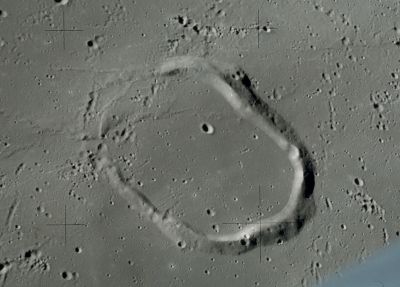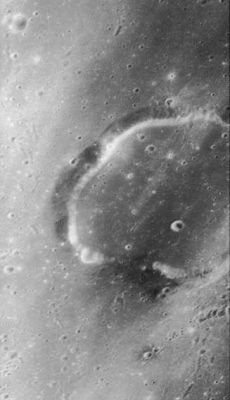Wallace
Contents
Wallace
|
Lat: 20.3°N, Long: 8.7°W, Diam: 26 km, Depth: 0.16 km, Rükl: 21 | |
| Apollo 17 image AS17-145-22283; click to enlarge |
Apollo 15 AS15-10221 |
Images
LPOD Photo Gallery Lunar Orbiter Images Apollo Images
- Wallace was also photographed during the mission of Apollo 12. In Hasselblad photograph AS12-50-7433 it (Wallace) is noticeable near the lower left corner of the frame.
- Wallace C, a bright ray-craterlet south-southeast of Wallace itself, at the slopes of Montes Apenninus, was photographed by Apollo 15 on Hasselblad film, see AS15-93-12584.
- Wallace during local sunrise: AS17-153-23591 (Hi-Res scan from Kipp Teague's Flickr gallery) (online since October 2015) (thanks Kipp!).
- Additional research: Danny Caes
Maps
(LAC zone 41D1) LAC map Geologic map LM map LTO map
Description
Wallace is a crater that just barely exists. It was formed on an earlier layer of Mare Imbrium lavas, presumably as a normal small complex crater with central peak and wall slump debris, but more lavas erupted and ultimately buried all but it's oval rim crest. It is peculiar that its inner and outer slopes are about equal in angle; typically inner slopes are much steeper than outer ones.
Description: Wikipedia
Additional Information
Depth data from Kurt Fisher database
- Westfall, 2000: 0.16 km
- Cherrington, 1969: 0.39 km
Curious clair-obscur phenomenae at Wallace
For those who want to observe curious lunar clair-obscur phenomenae through the telescope, Wallace is one of the most interesting lunar surface formations because during local sunrise circumstances (morning terminator) it (Wallace) looks like an illuminated ring! This phenomenon was photographed during the mission of Apollo 17 on Hasselblad and Fairchild camera frames, such as:
AS17-153-23591
AS17-M-1831
According to the Dutch observer of the moon A.J.M.Wanders, a remarkable system of three shadow spires (a "trident") is noticeable at Wallace's western rim when the morning terminator runs west of this crater. See Figure 85 on page 242 in the book Op Ontdekking in het Maanland (A.J.M.Wanders, 1949).
Nomenclature
- Alfred Russel Wallace, OM, FRS (8 January 1823 – 7 November 1913) was a British naturalist, explorer, geographer, anthropologist and biologist. He is best known for independently proposing a derived theory of natural selection which prompted Charles Darwin to publish his own more developed and researched theory sooner than intended.
- In his informal 1953 tour of Mare Imbrium, Leland Copeland referred to the row of hillocks between Wallace and Mons Wolff and Mons Serao in Montes Apenninus) as the Beaded Ridge. There's an orbital photograph of this feature in NASA SP-362 APOLLO OVER THE MOON, Chapter 3: The Terrae (Part 1), Figure 37. D.Caes research.
- The unnamed cluster of hillocks west-southwest of Wallace (at 19° North/ 11°30' West) is unofficially called the "Wallace hillocks" by Danny Caes. Apollo 17's orbital panoramic ITEK-camera frames AS17-P-3049/3054 show this cluster very well! It's rather strange to see no Greek Letter designations at these hills on Chart SLC D3 (System of Lunar Craters, 1966).
LPOD Articles
What is a Dome?
A Museum Piece (the illuminated ring effect at Wallace during local sunrise)
Bibliography
Alika Herring drawing and text, S&T October 1962, p. 218.

